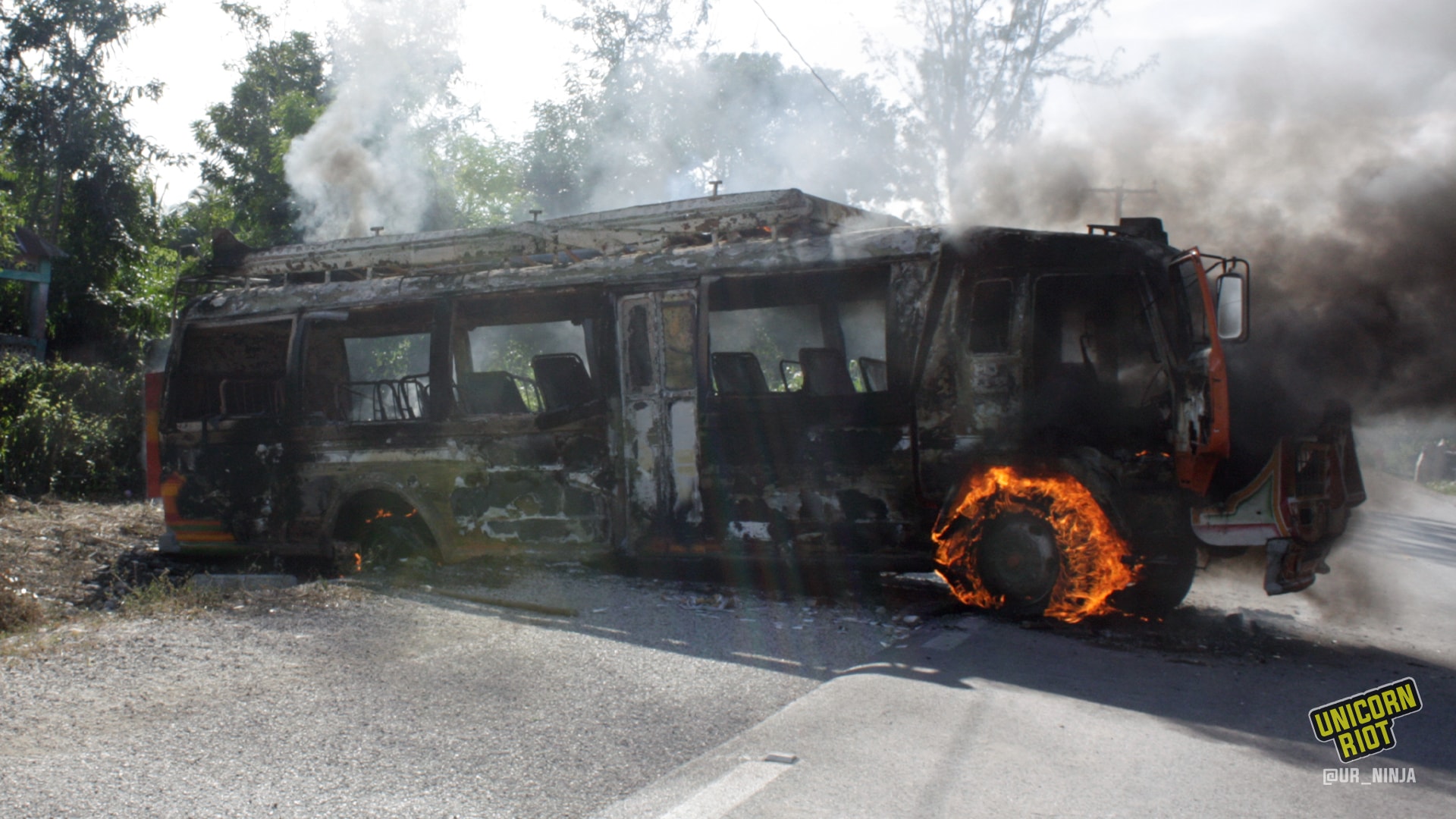Government Opens Fire as Bloody Revolution Gains Momentum in Haiti
Port-au-Prince, Haiti – Haiti has seen an uptick in protests, direct actions and deadly government repression in the last several weeks. Another round of anti-government protests hit the streets this past week in multiple regions across Haiti. Last Friday, videos released on social media showed destroyed police stations and large protests being met with gunfire. Those scenes were continued into this week.
https://twitter.com/haitiinfoproj/status/1177659782892679168?s=21
Haiti has been devastated by an onslaught of issues exacerbating unstable living conditions for most of the population. Recently-exposed political corruption involving the U.S.- and U.N.-backed President Jovenel Moise, coupled with rising prices and a fuel shortage, has pushed many thousands to hit the streets calling for Moise’s resignation.
In #Haiti, a 15 years of UN proxy occupation that brought death, disease, hunger and oppression has lead to a full-blown national resistance.
Tree branches in hand = Uprooting the oppressive, neocolonial system. The revolution will go on, whether it's televised or not. pic.twitter.com/S54OztvWrH
— Madame Boukman – Justice 4 Haiti 🇭🇹 (@madanboukman) September 27, 2019
At least four people have been killed by government forces in the past two weeks with many more injured. The total number of dead and wounded have yet to be fully established.
Sharing an island with the Dominican Republic that sits east of Cuba, Haiti has a special history. Officially the Republic of Haiti, it is the world’s first Black Republic and the first in the world to abolish slavery after being created from a successful revolution of formerly enslaved people.
After a call by President Jovenel Moise to take up arms against anti-government demonstrations, the Haiti Sentinel reported that at least 15 demonstrators in Cap-Haïtien were admitted to the hospital after being shot by unidentified gunmen on Friday.
#Haiti: More than 20 injured persons, at least 15 by gunfire, where according to reports, armed men fired on a group of government opponents in the Samarie district in north Cap-Haitien on Friday.https://t.co/seh3zqV2dR
— HaitiInfoProj (@HaitiInfoProj) September 28, 2019
In response to the heavy-handed tactics of the police, anti-government insurgents have disarmed multiple police officers, burned police vehicles and several police stations. The homes of government officials have also been burned.
Wealthy suburbs Delmas and Petion Ville saw looting and demonstrations, as well as reports of gunfire.
https://twitter.com/haitiinfoproj/status/1177659273074970624?s=21
Flaming road barricades have been established throughout the capital as well as other areas in the country.
Reportedly, following the liberation of prisoners who had been arrested in the last round of protests, the jail and central court in the southern port city of Jacmel were set ablaze.
Additional video released Monday shows hostilities continuing between protesters and police.
https://twitter.com/madanboukman/status/1178790006376284161
Residents of Cité Soleil, the most impoverished district in the capital of Port-au-Prince, ransacked a historically violent police station this past weekend.
Police uniforms, protective materials, and furniture were taken from the freshly deserted police station. Metal sheets from the building were to be re-purposed as roofs and floors in their own homes.
Police station in Cite Soleil, a slum area in the capital where the UN and police spent a decade massacring people was attacked. Police were forced to flee the wrath of the insurgents who then set fire to the vehicles and cleaned out the building. pic.twitter.com/0ojXQ5UkKz
— Madame Boukman – Justice 4 Haiti 🇭🇹 (@madanboukman) September 27, 2019
Cité Soleil was especially hard-hit after a 7.0 magnitude earthquake in 2010 left an estimated 300,000 people dead and displaced over a million. Scores of newly unsheltered people moved into the already crowded and dangerous conditions of the sprawling camp.
Many amputations were done in crude conditions and no pain medication. Survivors from the earthquake coped to deal with limbs broken under falling homes and buildings. These squalid health conditions persisted for years, leading to the worst modern outbreak of Cholera in decades.
Even before the earthquake and Cholera outbreak, the neighborhood of Cité Soleil was widely cited as one of the poorest and most dangerous slums in the entire Western Hemisphere. The sprawling area is home to between 200,000–400,000 residents.
We spoke with some residents of Cité Soleil in 2010 about the lack of jobs, education, and healthcare. Some of these residents self-identified as revolutionaries and acknowledged their involvement with armed actions against the government.
The call for further protests is likely to draw thousands into the streets. Facing a volatile future, the people demonstrating showed that they are willing to die to prompt change in Haiti.
https://twitter.com/HaitiInfoProj/status/1178777132358520832
For a more in-depth telling of Haiti’s political history, see An Unbroken Agony: Haiti, From Revolution to the Kidnapping of a President by Randall Robinson.
Stay tuned with Unicorn Riot for further coverage of this breaking story with more context, including exclusive interviews with revolutionaries based in Cité Soleil.
Cover image from Port-au-Prince, Haiti, November 2010
Please consider a tax-deductible donation to help sustain our horizontally-organized, non-profit media organization:



